- Home
- Shoulder Exercises
- Traps Stretches
Trapezius Stretches
Written By: Chloe Wilson BSc (Hons) Physiotherapy
Reviewed By: SPE Medical Review Board

Trapezius stretches are a great way to relieve neck, shoulder, upper and middle back pain.
Stress, posture and work habits are increasing the prevalence of pain and tight trapezius muscles.
This can lead to headaches, trigger points, restricted shoulder and neck movements and shoulder blade instability.
But trapezius stretches can make all the difference. Here, we will start with a quick overview of trapezius anatomy and function and the common causes of trapezius tightness and pain – if you want to know more, check out the trapezius pain section.
We will then focus on how to stretch your traps in a variety of different ways and positions so you can choose the right trapezius stretches for you.
Trapezius Anatomy & Function

Trapezius is a large, broad muscle that originates down the upper spine from the base of the skull down to the lower thoracic spine that fans out and attaches along the collar bone and shoulder blade.
The trapezius muscle can be divided into three parts, upper trapezius, middle trapezius and lower trapezius.
The main role of trapezius is to help control posture and shoulder blade stability so we have a stable base to work from. Functionally, our trapezius muscles allow us to:
- Bend our neck sideways and backwards and twist our neck round to the side
- Lower our shoulders against resistance: e.g. pushing up through hands when standing up from a chair
- Raise our arms above our heads
- Throw overarm
What Causes Tight Trapezius Pain?
Having tight trapezius muscles is an increasingly common problem, typically caused by:
- Posture: poor posture is the biggest cause for chronically tight trapezius muscles. We tend to spend more and more time on screens, sitting slumped over a desk or slouched on the sofa which leads to traps tightness
- Stress & Anxiety: we have a real tenancy to store tension in our shoulders which leads to tight trapezius muscles. When we feel stressed or anxious it’s common for our shoulders to tighten and gradually scrunch up towards our ears, and it’s trapezius that’s holding the majority of that tension
- Trigger Points: trapezius trigger points and muscle tightness go hand in hand. Small, tight nodules develop in the trapezius fascia which become hypersensitive. If you run your fingers over the back of your shoulder, just above your shoulder blade you may well be able to feel the knotted trapezius muscle under your fingers
Having super tight trapezius muscles can result in neck, shoulder and upper back pain, as well as tension headaches so it really helps to know how to stretch your traps. You can find out more about the common causes and symptoms in the trapezius pain article.
How To Stretch Trapezius
There are lots of different ways to do trapezius stretches and here you will find 7 of the best trapezius stretches that can be done in a range of positions to stretch the different parts of the muscle.
Whether you are looking for a trapezius stretch to do in the office while you work, something to ease your chronically tight trapezius muscles or simply want to loosen up your traps, there’s something here for everyone.
And the good news is, you don’t need any special equipment and you can do all of these trapezius exercises at home.
1. Shoulder Rolls
Shoulder rolls are a great place to start with trapezius stretches as they help get the muscle warmed up and loose before you start full on stretches, making them more effective
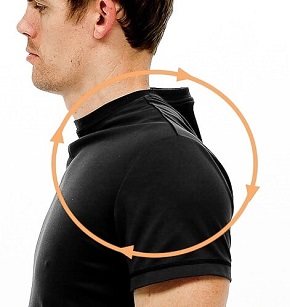
- Sit or stand in a comfortable position with good posture
- Roll both shoulders back and down and then forwards and up in a circular motion
- Start with small circles and gradually make the circles larger
- Spend 30-60 seconds doing this and then repeat in the opposite direction
2. Chin Tucks
Chin tucks, aka cervical retractions, are an absolute must for anyone with neck or trapezius pain. They help to realign the neck and ease the tension off the upper traps, combat a forward poking chin posture and loosen joints in the lower neck and upper back.
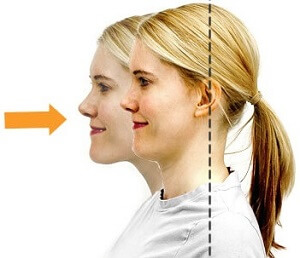
- Sit or stand upright in good posture
- Slowly draw your chin in towards your neck without tilting your head
- To ensure the correct technique, imagine your chin is sitting on a shelf and you are sliding your chin in along the shelf – it should feel like you are giving yourself a double chin
- Hold for 3 seconds and relax. Repeat 10-15 x
Top Tips: a. Imagine a piece of string pulling up through the center of your head, drawing your head upwards throughout, and keep the back of your neck long so you don’t let the head tilt.
b. It can really help to do chin tucks in front of the mirror when you first start. The movement often feels a little unnatural to start with and people often find themselves tilting their head or drawing their shoulders back instead of just tucking in the chin.
3. Upper Trap Side Bends
Side bends are one of the best upper trapezius stretches to start with for releasing chronically tight trapezius muscles. They can be modified to target different parts of the muscle and work well to relieve trapezius trigger points and knots. You want to start gently with these head tilts – don’t be tempted to over stretch too quickly else you may get some discomfort in your neck.

- Sit upright in a chair ensuring good posture
- Tilt your head to one side, taking your ear down towards your shoulder
- Keep your eyes and nose pointed forwards through
- Hold for 3 seconds and return to starting position
- Repeat to the other side, aiming for 10-15 reps each way
Progression: increase the stretch slightly further by placing your hand behind your back as shown before you start and keep it there throughout
4. Upper Trap Head Tilts
Head tilts are the next stage on after side bends if you are looking for stronger stretches for upper trapezius. Again, take things slowly to start with so as not to aggravate any neck or trapezius pain.
- Sit upright in a chair, ensure good posture and hold the bottom of the chair with one hand
- Tilt your head to the opposite side, taking your ear towards your shoulder
- Anchoring your shoulder down by holding the bottom of the chair helps increase the trapezius stretch
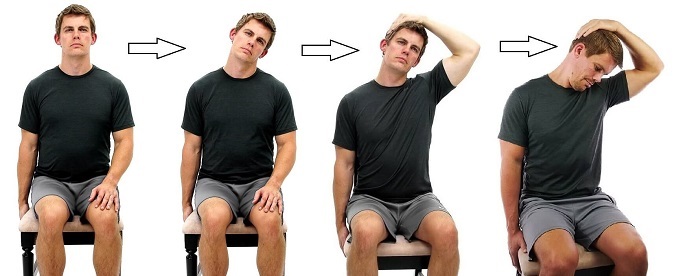
Progressions: 1. Place you free hand over the side of your head (towards the back) and gently pull your head further over for a stronger stretch
2. Once your head is tilted over to the side, turn your head to look down towards your hip – you should feel the traps stretch further back
3. Combine progression 1 & 2 for an even stronger upper traps stretch
Top Tip: If you don’t have a suitable chair that you can hold onto, sit on your hand to anchor the arm down
5. Middle Trapezius Stretch
This is a great middle trapezius stretch for stretching both sides at the same time and can again be modified to increase the stretch further as your muscles relax.
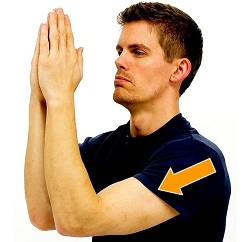
- Sit or stand ensuring good posture
- Place your hands and forearms together as shown
- Draw your shoulders and shoulder blades forwards until you feel a stretch along your upper back
- Hold for 15-30 seconds and repeat 3-5 times
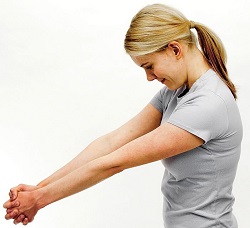
Progressions: 1. Interlace your fingers and draw your hands forwards until you feel a stretch across your upper back
2. Increase the stretch further by bringing your chin down towards your chest
Top Tip: You can change which fibres you stretch for trapezius by varying the angle of your arms/height of your hands
6. Sideways Child’s Pose
This twist on the yoga child's pose position is a lovely stretch for trapezius and the upper back.
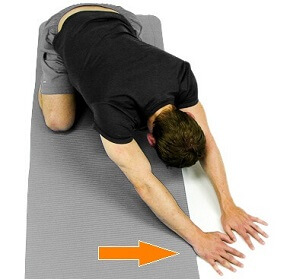
- Kneel on all fours, hands under shoulders, knees under feet
- Slowly sit your buttocks back onto your feet, letting your chest come down to the floor
- Holding the position, gradually slide/walk your hands out to the side to stretch out your tight trapezius muscle
- Hold for 30 seconds, then take your hands over to the other side and repeat
- Return to starting position and then repeat 2-3 times each way
Progression: You can increase the middle and lower trapezius stretch by taking in a couple of deep breath as you hold the stretch
7. Massage Ball Stretches
If you are wanting to know how to stretch trapezius trigger points or knots, then then massage ball stretches are perfect. If you don’t have a massage ball you can use a tennis ball, lacrosse/hockey ball, racquet ball or even a golf ball. There are loads of different variations to stretch different parts of the trapezius muscle - we'll start with the basics and work on from there.
NB Don’t roll over bony areas e.g. shoulder blades or spine – you should be rolling through the trapezius muscle.
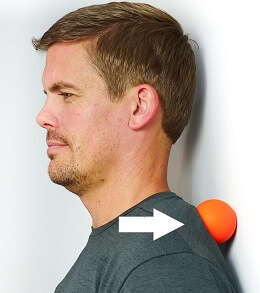
- Stand with your back towards the wall and place the ball behind your back over the trapezius knot/tight area
- Lean back into the ball to apply gentle pressure to stretch trapezius
- For a knotted trapezius muscle hold the pressure for 30-60 seconds, for a chronically tight trapezius roll the ball in small movements (up/down, side/side or circles) for 1-2 minutes
Progression: To stretch further through the trapezius muscle without moving your body, raise both arms, either out on front of you or out to the side – it gives a lovely dynamic stretch to the trapezius muscles
Upper Trapezius Stretches With Ball
If you are looking to use the massage ball for upper trapezius stretches, there are a few different ways you can do it:

Upper Trapezius Stretch 1: Lie on your stomach, rest your head onto one hand and use the other hand to roll the ball around to gently massage around the base of the skull and the side of the neck
Upper Trapezius Stretch 2: Lie on the floor and place the ball underneath you at the back of the upper traps. Move the ball to the trapezius knot, push gently into the ball and hold. Or for a more general super tight trapezius stretch roll the ball around
Upper Trapezius Stretch 3: If you have a super tight trapezius right at the top of your shoulder, lie on the floor in an open doorway so your head goes through the door and your shoulder is lined up with the wall. Place the ball between the wall and your upper trapezius muscle and scoot closer to the wall to apply pressure through the tight or knotted trapezius muscle.
Upper Trapezius Stretch 4: Stand by an open doorway and bend at the waist so your shoulder is lined up with the wall. Place a ball on the top part of your trapezius, between your neck and shoulder, lean into the ball and hold the upper trapezius stretch.
Middle Trapezius Stretch With Ball
For middle trapezius stretches, move the ball down to area you want to stretch between the shoulder blade and spine (avoiding bone).

- Place a ball between the wall and your middle trapezius muscle
- Lean into the ball and apply gentle pressure to the tight area
- For middle trapezius trigger point release, hold the pressure directly through the trapezius knot
- For a more general middle trapezius stretch, bend and straighten your knees to roll the ball up and down through the muscle
Lower Trapezius Stretch With Ball
To do lower trapezius stretches with the massage ball, simply move the ball down over the lower part of the rib cage.

- Stand with your back to the wall and place a ball between the wall and your lower traps
- Bend and straighten your knees to roll the ball up and down to stretch through the lower traps
- It is much less common to get lower traps trigger points/knots than in the upper or middle traps, but if you do, hold the pressure through the ball over the trigger point rather than moving the ball.
What Else Can Help?
Trapezius stretches should not be done in isolation. It is also important to work on both posture and muscle strength else there is a high chance the muscles will tighten up again and cause ongoing pain. So ideally, alongside these trapezius stretches, it will also help to do:
- Upper Back Stretches: having tight trapezius muscles is often linked with upper back tightness and stiffness so it is important to stretch out the thoracic spine too
- Scapular Stabilization Exercises: targeting the lower traps to improve shoulder blade strength and control
- Improve Your Posture: especially if you sit in front of a screen for long periods – check out our top tips!
If you are suffering from pain in the trapezius muscles alongside tightness, there are lots of other things you can do alongside trapezius stretches to help such as massage, changing your sleep position and using heat – you can find out loads more in the Trapezius Pain: Causes & Treatment article
Page Last Updated: March 28th, 2024
Next Review Due: March 28th, 2026


